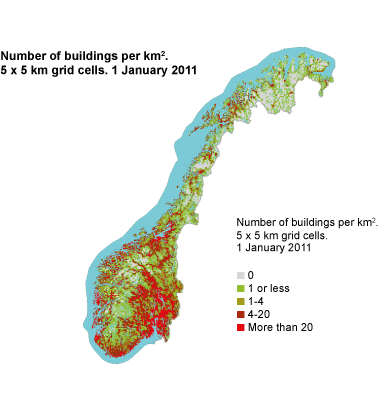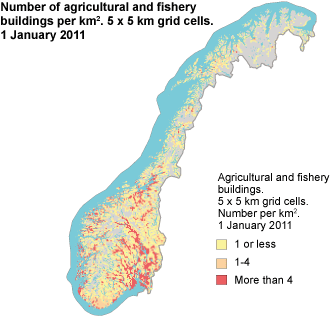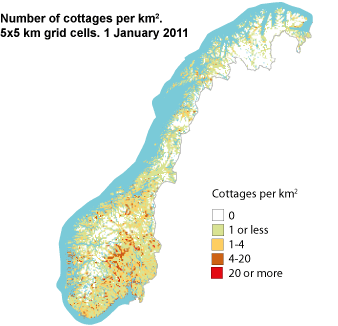Content
Published:
This is an archived release.
Building stock on map
A census of building stock shows that there are almost 4 million buildings in Norway, whereof close to 1.5 million are residential buildings. The building stock statistics are now displayed on maps.
Well over one third of the building stock; 1 466 389 buildings, are residential buildings. The rest are broken down into 746 569 industrial buildings and 1 725 452 holiday houses, residential garages etc. Agricultural and fishery buildings is the largest category by number of buildings in the industrial sector, with 509 557 buildings.
Makes use of the country
Although sparsely populated, a large part of the country is close to a building. By counting the buildings within cells in a geographic grid, it is possible to see how the building stock is spatially distributed. Divided into different groups of buildings it is also possible to see differences in geographic patterns and concentrations of buildings. In figures 1, 2 and 3, buildings are counted within 5 x 5km grid cells.
Figure 1 shows total buildings per square kilometre. The highest concentrations of buildings are found in cities and near larger urban settlements, along the coastline in Southern Norway, and near larger harbours and traffic nodes.
Figure 2 shows the number of agricultural and fishery buildings per square kilometre. These buildings are much less concentrated than for buildings in general. The largest concentrations of agricultural and fishery buildings are situated around cities and urban settlements in areas dominated by agricultural areas and forestry.
Almost 440 000 cottages
The building stock increased net by 9 164 cottages last year, of which 2 165 are detached houses and farmhouses used as holiday houses.
Figure 3 shows the number of cottages per square kilometre. As with agricultural and fishery buildings, cottages are also less concentrated than for buildings in general. The largest concentrations are found mainly in Southern Norway, along climatically favourable coastlines, and in mountain areas and valleys east of the southern mountain ranges.
Basis for statisticsThe statistics are based on data from the Ground Property, Address and Building Register (Matrikkelen). The municipalities record data in the Matrikkel. All buildings in Norway larger than 15 m2 are recorded in the register with a code for building type and coordinates. The statistics may include buildings that are demolished, burnt down or otherwise non-existent, where these are not reported to the authorities. Connected units are recorded as separate buildings when the units can be demolished independently of each other. A single dwelling in row houses and in semi-detached houses is recorded as one building. Causes for changes in building stockMunicipalities clean their registers at different intervals in order to improve quality. As a result, buildings that were not classified one year are assigned their correct building type the following year. In addition, incorrectly classified buildings are assigned their correct building type code. The number of registered buildings in a municipality may therefore change from one year to the next. More statistics on gridsStatistics Norway aims to make more statistics available on grids. Statistics on grids are made according to a national standard grid for official statistics. For more statistics on grids and information about grid cell sizes etc, see the home page for grid statistics (in Norwegian only). |
More figures are available in
StatBank
.
Contact
-
Jens Mathiesen
E-mail: jens.mathiesen@ssb.no
tel.: (+47) 40 81 13 98
-
Mona Takle
E-mail: mona.takle@ssb.no
tel.: (+47) 40 81 14 12



